In the world of online advertising, understanding the difference between Cost-Per-Click (CPC) and Cost-Per-Impression (CPI) is crucial for optimizing your campaigns. CPC charges advertisers only when users click on their ads, making it ideal for driving traffic and conversions. Conversely, CPI focuses on brand visibility by charging for ad impressions, regardless of user interaction. Choosing the right model depends on your specific advertising goals and desired outcomes.
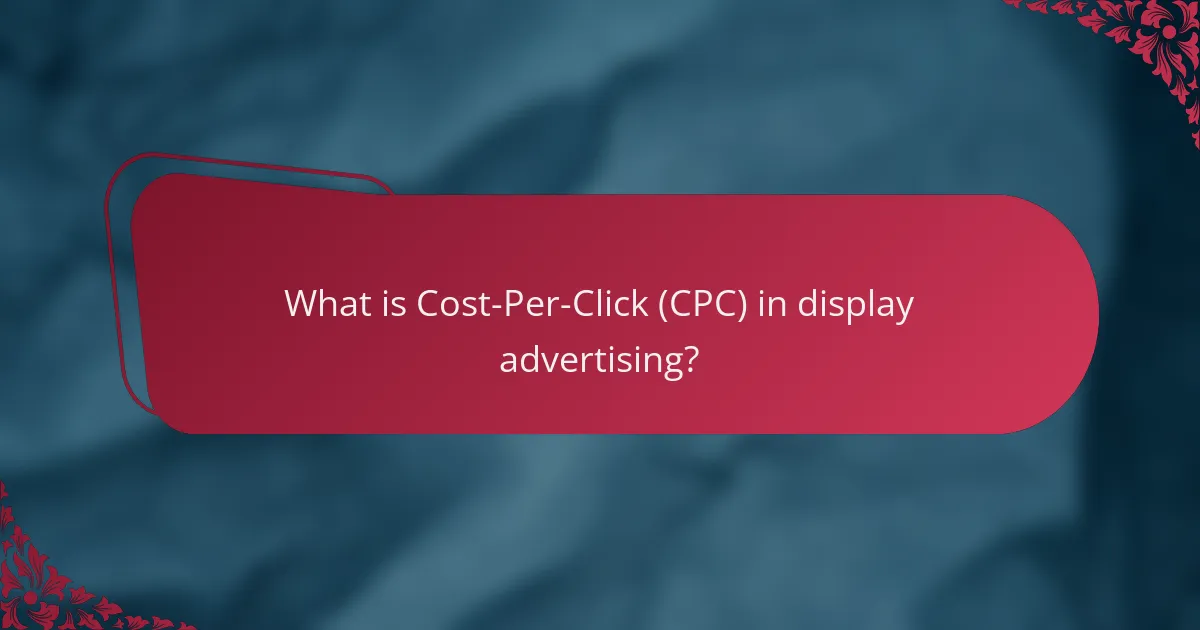
What is Cost-Per-Click (CPC) in display advertising?
Cost-Per-Click (CPC) in display advertising refers to the amount an advertiser pays each time a user clicks on their ad. This model is popular for driving traffic to websites, as it directly correlates costs with user engagement.
Definition of Cost-Per-Click
Cost-Per-Click is a pricing model used in online advertising where advertisers pay a fee each time their ad is clicked. This approach allows advertisers to only incur costs when a potential customer shows interest by clicking on the ad, making it a performance-based method.
In contrast to other models like Cost-Per-Impression (CPI), where advertisers pay for ad views regardless of interaction, CPC focuses on actual engagement. This makes it particularly appealing for campaigns aimed at generating leads or sales.
How CPC works in campaigns
CPC operates through bidding systems where advertisers set a maximum amount they are willing to pay for each click. This bid is often influenced by factors such as the competitiveness of the keywords, the quality of the ad, and the target audience.
Advertisers can use platforms like Google Ads to manage their CPC campaigns. They can analyze performance metrics to adjust bids, optimize ad placements, and refine targeting strategies. A common practice is to start with a moderate bid and gradually increase it based on the campaign’s performance.
When implementing a CPC strategy, it’s crucial to monitor conversion rates to ensure that clicks translate into desired actions, such as purchases or sign-ups. Setting clear goals and regularly reviewing campaign performance helps maximize the effectiveness of CPC advertising.
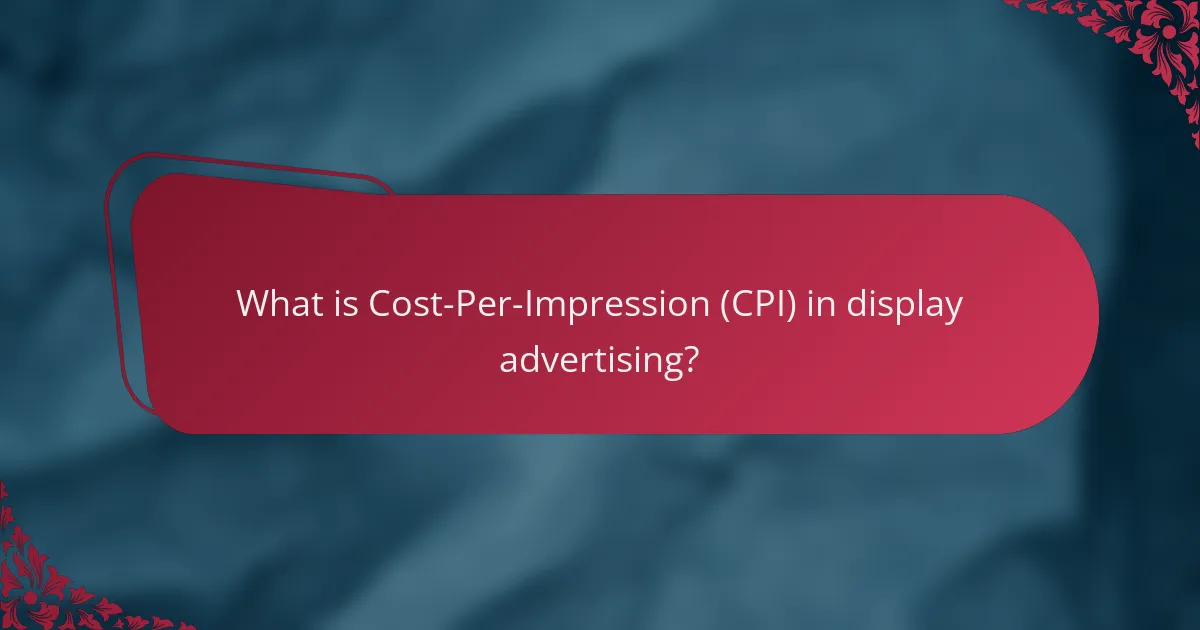
What is Cost-Per-Impression (CPI) in display advertising?
Cost-Per-Impression (CPI) is a pricing model in display advertising where advertisers pay for each time their ad is displayed, regardless of whether it is clicked. This model is often used to increase brand visibility and reach a larger audience.
Definition of Cost-Per-Impression
Cost-Per-Impression refers to the cost incurred by advertisers each time their advertisement is shown to a user. This metric is crucial for campaigns focused on brand awareness rather than direct conversions. Advertisers typically pay a set amount for every thousand impressions, known as CPM (cost per mille).
In this model, the focus is on the number of times an ad is viewed, rather than the actions taken by viewers. This makes CPI a popular choice for businesses looking to enhance their visibility in a crowded market.
How CPI works in campaigns
CPI operates by charging advertisers based on the number of impressions their ads receive. Advertisers set a budget for their campaigns, and the ad platform distributes the ads to reach as many users as possible within that budget. The effectiveness of CPI campaigns can be measured through metrics such as reach and frequency.
When planning a CPI campaign, it’s essential to target the right audience to maximize the impact of each impression. Advertisers should consider factors like demographics, interests, and online behavior. Monitoring performance and adjusting targeting can help optimize results.

When should you use Cost-Per-Click?
Cost-Per-Click (CPC) is best used when your goal is to drive traffic to your website and you want to pay only for actual clicks. This model is particularly effective for campaigns focused on conversions, where each click has the potential to lead to a sale or a lead generation.
Best scenarios for CPC usage
CPC is ideal for businesses aiming to increase website visits or generate leads. If you have a clear call-to-action, such as signing up for a newsletter or purchasing a product, CPC can be a suitable choice. Additionally, it works well in competitive markets where attracting attention quickly is crucial.
Consider using CPC when you have a limited budget and want to ensure that your spending directly correlates with user engagement. This model allows for better control over your advertising expenses, as you only pay when someone clicks on your ad.
Advantages of using CPC
One of the primary advantages of CPC is its cost-effectiveness; you only pay for actual clicks, making it easier to manage your advertising budget. This model also allows for precise tracking of campaign performance, enabling you to analyze which ads are driving traffic and conversions.
Another benefit is the flexibility it offers in targeting specific audiences. With CPC, you can tailor your ads to reach users who are more likely to engage with your content, thus improving your return on investment. Additionally, CPC campaigns can be adjusted in real-time based on performance metrics, allowing for quick optimization.

When should you use Cost-Per-Impression?
Cost-Per-Impression (CPI) is best used when your goal is to increase brand awareness rather than drive immediate clicks. This model charges advertisers for every 1,000 impressions, making it suitable for campaigns focused on visibility and reach.
Best scenarios for CPI usage
CPI is particularly effective for campaigns targeting broad audiences where brand recognition is key. For instance, launching a new product or promoting a brand refresh benefits from high visibility, making CPI a fitting choice.
Additionally, if your target audience is less likely to convert immediately but can be influenced over time, CPI allows you to maintain a presence in their feed without the pressure of immediate engagement.
Advantages of using CPI
One major advantage of CPI is cost efficiency in reaching large audiences. Since you pay for impressions rather than clicks, you can maximize exposure without needing immediate action from viewers.
CPI campaigns can also provide valuable data on audience behavior and preferences, as impressions can help gauge interest levels. This insight can inform future strategies, allowing for more targeted approaches in subsequent campaigns.
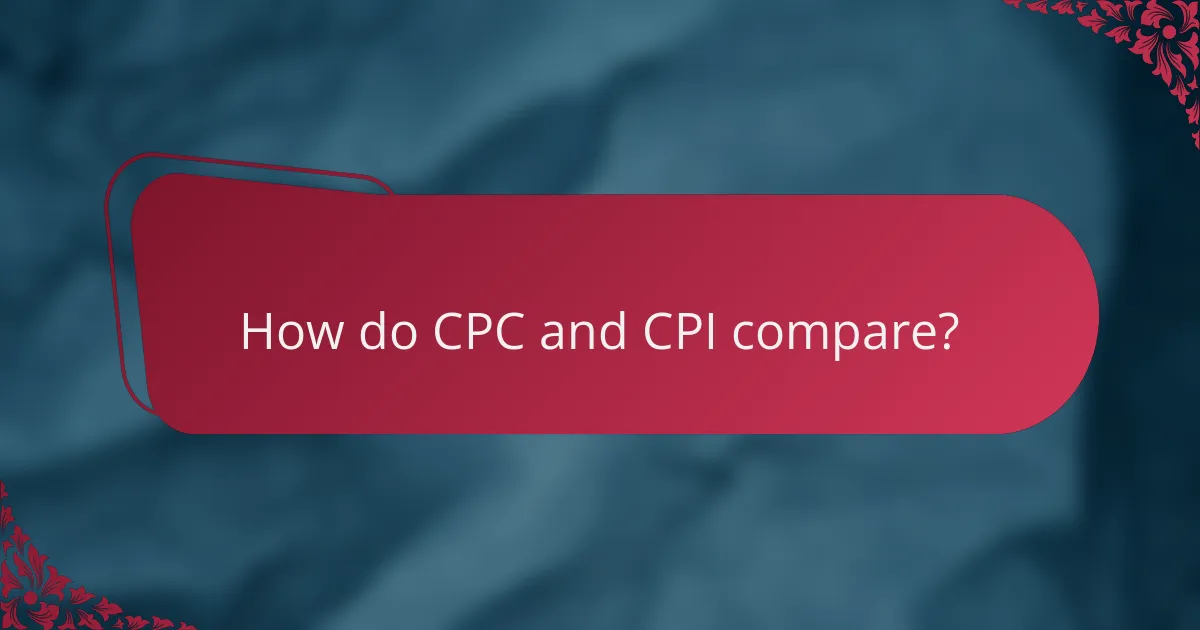
How do CPC and CPI compare?
Cost-Per-Click (CPC) and Cost-Per-Impression (CPI) are two distinct pricing models used in online advertising. CPC charges advertisers each time a user clicks on their ad, while CPI charges based on the number of times the ad is displayed, regardless of clicks.
Key differences between CPC and CPI
The primary difference between CPC and CPI lies in how advertisers are billed. With CPC, the focus is on driving traffic to a website, making it ideal for campaigns aimed at generating leads or sales. In contrast, CPI is more suited for brand awareness campaigns, where visibility is the main goal, and the cost is incurred simply by showing the ad.
Another key difference is the level of engagement. CPC campaigns often yield higher engagement rates since users are more likely to click on ads that interest them. Conversely, CPI may lead to lower engagement, as impressions do not guarantee interaction.
Cost-effectiveness analysis
To determine which model is more cost-effective, consider your campaign goals. If your aim is to drive conversions, CPC may provide better value as you only pay for actual clicks. However, if you’re looking to increase brand visibility, CPI can be more economical, especially if your target audience is large.
When analyzing costs, keep in mind that CPC rates can vary significantly based on industry and competition, often ranging from a few cents to several dollars per click. CPI rates are generally lower, but the effectiveness can depend on the ad’s reach and the target market. Always assess your return on investment (ROI) to ensure you’re choosing the right model for your advertising strategy.
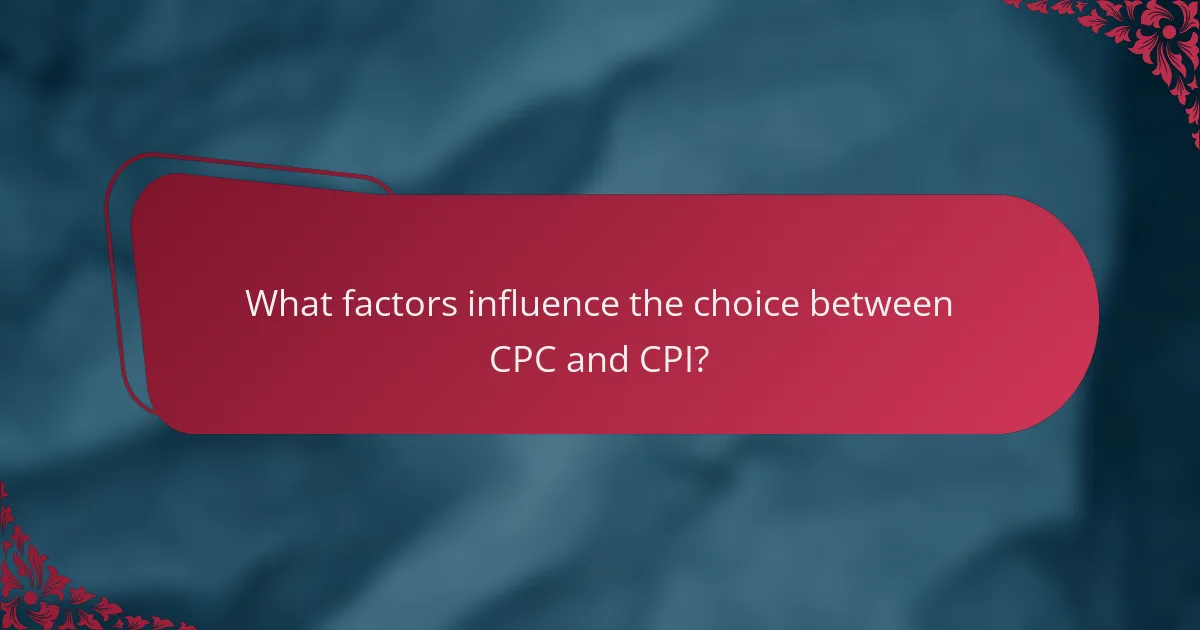
What factors influence the choice between CPC and CPI?
The choice between Cost-Per-Click (CPC) and Cost-Per-Impression (CPI) depends on various factors, including your target audience, campaign goals, and the nature of your advertising strategy. Understanding these elements can help you select the most effective pricing model for your needs.
Target audience considerations
When determining whether to use CPC or CPI, consider the behavior and preferences of your target audience. If your audience is more likely to engage with ads through clicks, CPC may be the better option. Conversely, if brand visibility is crucial and your audience responds well to impressions, CPI could be more effective.
Additionally, analyze where your audience spends their time online. For platforms with high engagement rates, CPC can yield better returns, while platforms focused on brand awareness may benefit from CPI strategies.
Campaign goals and objectives
Your campaign’s specific goals will significantly influence the choice between CPC and CPI. If your primary objective is to drive traffic to your website or generate leads, CPC is often the preferred model, as you only pay when users click on your ad.
On the other hand, if your goal is to increase brand awareness or reach a larger audience, CPI may be more suitable. This model allows you to pay for ad visibility, which can be beneficial for campaigns focused on long-term brand recognition rather than immediate conversions.
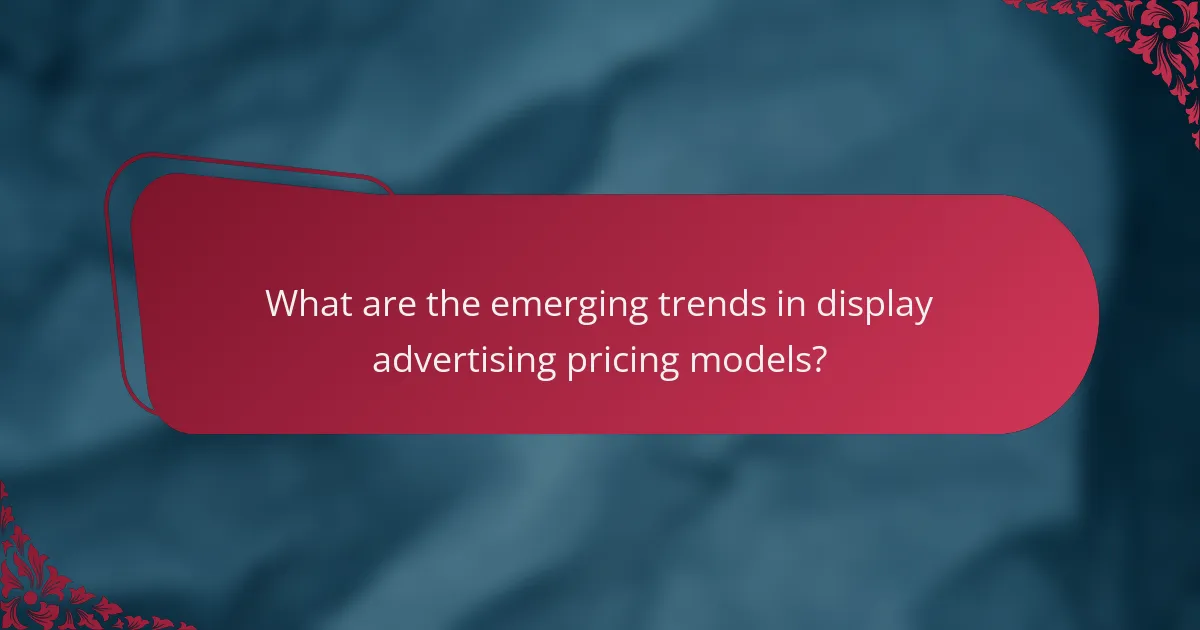
What are the emerging trends in display advertising pricing models?
Emerging trends in display advertising pricing models indicate a shift towards more flexible and performance-driven approaches. Advertisers are increasingly exploring hybrid models that combine elements of both cost-per-click (CPC) and cost-per-impression (CPM) to optimize their campaigns.
Shift towards hybrid models
Hybrid pricing models integrate CPC and CPM strategies, allowing advertisers to benefit from both approaches. This flexibility enables marketers to pay for impressions while also incentivizing clicks, which can lead to better overall performance. For example, a campaign might use CPM to build brand awareness initially and switch to CPC as it targets users more likely to convert.
Advertisers should consider their specific goals when choosing a hybrid model. If brand visibility is the priority, starting with a CPM approach may be advantageous. Conversely, if driving immediate actions is crucial, focusing on CPC can yield better results.
Impact of AI on pricing strategies
Artificial intelligence is transforming pricing strategies in display advertising by enabling more precise targeting and real-time bidding. AI algorithms analyze vast amounts of data to predict user behavior, allowing advertisers to adjust their bids dynamically based on performance metrics.
For instance, AI can optimize ad placements by determining the best times and platforms to reach specific audiences, potentially lowering costs and increasing return on investment. Advertisers should leverage AI tools to refine their pricing strategies, ensuring they remain competitive in an evolving landscape.


